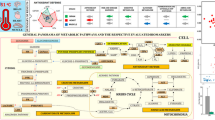Abstract
Rhithropanopeus harrisii (Gould) is an introduced species in the estuary of the Mondego River (Portugal): it was first recorded from the Iberian Peninsula in 1989. The larval development of this population was studied under laboratory conditions at different temperatures and salinities, and showed a larval development pattern very similar to that reported for American estuarine populations of this species. Larval development was negatively correlated with temperature. Time to megalopa varied between 7 and 35 d; the first crab (C1) was reached after a maximum of 11 to 43 d. Larval development was optimum at 25°C and 15‰S. Larval survival was maximum at 10, 15 and 20‰S at all three temperatures studied (20, 25 and 30°C). The percentage of abnormal megalopae increased with increasing salinity to a maximum (100%) at 30‰S; incidence of abnormality was not affected by temperature.
Similar content being viewed by others
References
Anger K, Harms J, Püscel C, Seeger B (1989) Physiological and biochemical changes during the larval development of a brachyuran crab reared under constant conditions in the laboratory. Helgoländer Meeresunters 43:225–244
Bookhout CG, Costlow JD, Jr (1970) Nutritional effects of Artemia from different locations on larval development of crabs. Helgoländer Meeresunters 20:435–442
Christiansen ME, Costlow JD, Jr (1975) The effect of salinity and cyclic temperature on larval development of the mud-crad Rhithropanopeus harrisii (Brachyura: Xanthidae) reared in the laboratory. Mar Biol 32:215–221
Connolly CJ (1925) The larval stages and megalops of Rhithropanopeus harrisii (Gould). Contr Can Biol Fish 2:329–334
Costlow JD, Jr, Bookout CG (1971) The effect of cyclic temperature on larval development in the mud crab Rhithropanopeus harrisii. Proc. 4th Eur mar Biol Symp. 211–220 [Crisp DJ (ed) Cambridge University Press, Cambridge]
Costlow JD, Jr, Bookhout CG, Monroe R G (1966) Studies on the larval development of the crab Rhithropanopeus harrisii (Gould). I. The effects of salinity and temperature on larval development. Physiol Zoöl 39:81–100
Finney DJ (1971) Probit analysis. Cambridge University Press, London
Gonçalves F (1991 a) Zooplâncton do estuário do Rio Mondego: distribuição e abundância (Maio a Agosto de 1988). Revta Biol Univ Aveiro 4:173–185
Gonçalves F (1991 b) Zooplâncton e ecologia de crustáceos decápodes no Estuário do Rio Mondego (Portugal). Ph. D. thesis. Department of Zoology of the University of Coimbra, Coimbra
Harms J (1990) Accumulation and loss of biomass in Liocarcinus holsatus larvae during growth and exuviation. Mar Biol 104: 183–190
Laughlin RB, Jr, French W (1989) Differences in responses to factorial combinations of temperature and salinity by zoeae from two geographically isolated populations of the mud crab Rhithropanopeus harrisit. Mar Biol 102:387–395
Mene L, Alvarez-Ossorio MT, González-Gurriarán E, Valdés L (1991) Effects of temperature and salinity on larval development of Necora puber (Brachyura: Portunidae). Mar Biol 108:73–81
Mohamedeen H, Hartnoll RG (1989) Larval and postlarval growth of individually reared specimens of the common shore crab Carcinus maenas (L.). J exp mar Biol Ecol 134:1–24
Morgan SG, Goy JW, Costlow JD, Jr (1988) Effect of density, sex ratio, and refractory period on spawning of the mud crab Rhithropanopeus harrisii in the laboratory. J Crustacean Biol 8:245–249
Rosenberg R, Costlow JD, Jr (1979) Delayed response to irreversible non-genetic adaptation to salinity in early development of the brachyuran crab Rhithropanopeus harrisii, and some notes on adaptation to temperature. Ophelia 18:97–112
Sastry AN (1983) Pelagic larval ecology and development In: Vernberg FJ, Vernberg WB (eds) The biology of Crustacea. Vol. 7. Academic Press, New York, pp 213–282
Sulkin SD, McKeen GL (1989) Laboratory study of survival and duration of individual zoeal stages as a function of temperature in the brachyuran crab Cancer magister. Mar Biol 103:31–37
Werding B, Müller H-G (1990) Larval development of Neopisosoma neglectum Werding, 1986 (Decapoda: Anomura: Porcellanidae) under laboratory conditions. Helgoländer Meeresunters 44:363–374
Author information
Authors and Affiliations
Additional information
Communicated by J. M. Pérès, Marseille
Rights and permissions
About this article
Cite this article
Gonçalves, F., Ribeiro, R. & Soares, A.M.V.M. Laboratory study of effects of temperature and salinity on survival and larval development of a population of Rhithropanopeus harrisii from the Mondego River estuary, Portugal. Marine Biology 121, 639–645 (1995). https://doi.org/10.1007/BF00349299
Received:
Accepted:
Issue Date:
DOI: https://doi.org/10.1007/BF00349299




